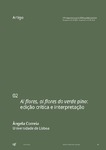Ai flores, ai flores do verde pino: edición crítica e interpretación

Ver/
Use este enlace para citar
http://hdl.handle.net/2183/32658
A non ser que se indique outra cousa, a licenza do ítem descríbese como Atribución-CompartirIgual 4.0 Internacional (CC BY-SA 4.0)
Coleccións
Metadatos
Mostrar o rexistro completo do ítemTítulo
Ai flores, ai flores do verde pino: edición crítica e interpretaciónAutor(es)
Data
2022-12-27Cita bibliográfica
Correia, Ângela. (2022). Ai flores, ai flores do verde pino: edición crítica e interpretación. Revista Galega de Filoloxía, 23, 19-35. https://doi.org/10.17979/rgf.2022.23.0.9141
Resumo
[Resumo] A cantiga Ai flores, ai flores do verde pino, de D. Denís, é unha das máis coñecidas da lírica galego-portuguesa e unha das máis representativas do xénero “cantiga de amigo”. Os manuscritos que a transmitiran (Cancioneiro da Biblioteca Nacional e Cancioneiro da Vaticana) presentan diverxencias sorprendentes, que teñen sido resolvidas nas edicións críticas de forma consensual. Hai, no entanto, razóns para rever este consenso. Por outro lado, tratándose dunha cantiga dialogada, ten tamén habido consenso na atribución do refrán sempre á mesma voz, interrompendo o discurso da segunda voz. A interpretación que conduciu a esta opción e a inscrición da cantiga nunha tradición popularizante pode ser cuestionada con base no entendemento de que D. Denís adapta parte da técnica das cantigas de seguir para obter unha alegoría sentimental e o retrato dunha figura feminina en aflición. [Abstract] The song Ai flores, ai flores do verde pino, by D. Dinis, is one of the best known of Galician-Portuguese lyric and one of the most representative of the cantiga de amigo genre. The manuscripts that transmitted it (Cancioneiro of the National Library and Cancioneiro of the Vatican Library) show surprising divergences, that have been solved in a consistent way in critical editions. However, there are reasons to review this consensus. On the other hand, since this is a song where dialogue takes place, there has also been consensus in attributing the refrain always to the same voice, interrupting the speech of the second voice. The interpretation that led to this option and to inserting the song into a folk-like tradition can be questioned based on the understanding that D. Dinis adapts part of the technique of the cantigas de seguir to obtain a sentimental allegory and the portrait of a female figure in distress.
Palabras chave
D. Dinis
Cantiga de amigo
Edição crítica
Cantiga de seguir
Cancioneiros
Critical edition
Song books
Cantiga de amigo
Edição crítica
Cantiga de seguir
Cancioneiros
Critical edition
Song books
Versión do editor
Dereitos
Atribución-CompartirIgual 4.0 Internacional (CC BY-SA 4.0)






